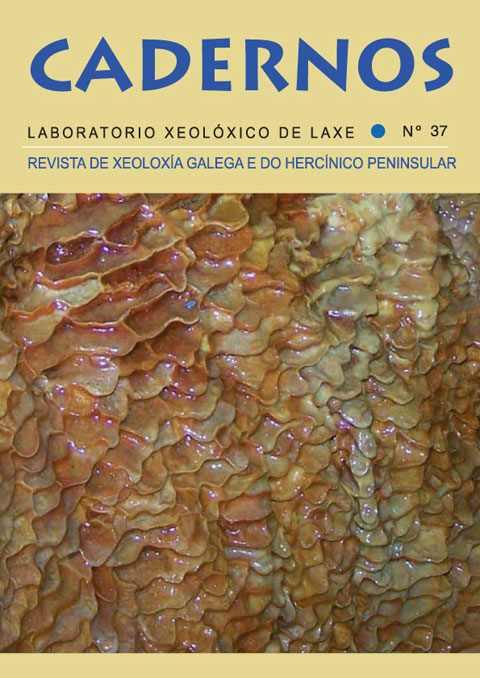Geological sketch and the non-karstic caves of the Bakony Mountains in Hungary
Main Article Content
Abstract
The about 4000 km2 Bakony Mountains form the most extensive region of the Trans-Danubien Mountains between Lake Balaton and Marcal River. They have a typical medium relief, including plateaux of various heights, and denudated fault blocks interspersed with inter mountain basins. In the southern and western areas of the mountains, basalt cones and basaltic sheets are frequently found. In the central area, the variously sloping landscape is inclined towards the blocks. Limestone and dolomite predominate, and there are extensive karst regions and numerous karst caves. Of course, from the point of view of the non-karstic caves, these regions are insignificant. Significantly smaller is the occurrence of quartziferous (sandstone and conglomerate) and basalt rocks, however 147 non-karstic cave are known in these rocks and, in addition, 35 artificial cavities, considered as caves, are listed. The authors describe the geology, the geomorphology and the non-karstic cave development of the Bakony Mountains. Furthermore, typical examples of the caves have been selected and presented according to the different rock formations and development types.
Keywords:
Downloads
Article Details
References
Bertalan, K. (1958). Magyarország nem karsztos eredetű barlangjai (nonkarstic Caves of Hungary) - Karszt- és Barlangkutatási Tájékoztató (jan-jún), Budapest: p. 13-21.
Buckó, E. (1970). A Tihanyi-félsziget geomorfológiája, In Bialik: Magyarázó a Balaton környéke 1:10.000 építésföldtani térképsorozatához – Tihany. (Geomorphology of the Tihanyi Peninsula, In Bialik: Explanatory Note for the Engineering Geological Map of Lake Balaton Region – Tihany, 1 : 10 000) Hungarian Geological Survey Publication, bp. 1970. P. 47-55.
Cholnoky, J. (1931). Tihany, morfológiai megfigyelések (Morphological Observations in Tihany Peninsula) - Matematikai és Természettudományi Értesítő (48. köt. 1. füzet), -budapest p. 225- 227.
Eszterhás, I. (1983). A Bakony barlangjai (Caves of the Bakony Mountains) - in Mészáros: Bakony, Balaton-felvidék - Medicina Könyvkiadó, Budapest p. 45-71.
Eszterhás, I. (1984). Lista a Bakony barlangjairól (List of the Caves in the Bakony Mountains) - Folia musei historico-naturalis Bakonyiensis, zirc p. 13-30.
Eszterhás, I. (1985). A Kapolcsi Pokollik (The Kapolcsi Pokol Hole) – Folia musei historico-naturalis Bakonyiensis, Zirc, p. 39-42.
Eszterhás, I. (1986). A Pulai bazaltbarlang és környéke (The Pulai Basalt Cave and its surrounding)- Karszt és Barlang (i. füzet), Budapest, p. 23-32.
Eszterhás, I. (1987-a). A Bakony bazaltbarlangjai (Basalt Caves in the Bakony Mountains) - Föld és Ég (22. évf. 12.sz). Budapest, p. 360-364.
Eszterhás, I. (1987-b). A Tihanyifélsziget barlangkatasztere (List of the Caves in the Tihanyi Peninsula) – Bakony Természettudományi Kutatásának Eredményei (18. Köt). Zirc p. 1-84.
Eszterhás, I. (1988-a). A Tátika bazaltbarlangjai (Basalt Caves in Mount Tátika) – Folia musei historico-naturalis Bakonyiensis (7. sz.) Zirc, p. 13-22.
Eszterhás, I. (1988-b): a Kovácsi-hegy bazaltbarlangjai (Basalt Caves in Mount Kovácsi) Folia musei historico-naturalis Bakonyiensis (7. sz), Zirc, p. 23-36.
Eszterhás, I. (1988-c). A magyarországi bazaltbarlangok kutatottságának eredményei (Results of Basalt Cave Research in Hungary) – Karszt és Barlang (1988 I. Füzet), Budapest, p. 15-20.
Eszterhás, I. (1984-a). A Pokol-lik (The Pokol Hole) – Lychnis, a Vulkánszpeleológiai Kollektíva kiadványa, Kapolcs, p. 28-35.
Eszterhás, i. (1984-b). Magyarország jégbarlangjai (Ice Caves in Hungary) – Lychnis, a Vulkánszpeleológiai Kollektíva kiadványa, Kapolcs, p. 36-42.
Eszterhás, I. (1993). Genotypes of caves in volcanic rocks in Hungary – Conference on the karst and research activities of educational and research institutions in Hungary, Jósvafő, p. 81-86.
Eszterhás, I., Szentes, G. (2004). Magyarország nemkarsztos barlangjainak katasztere – (A List of Non-karstic Caves in Hungary). http://geogr.elte.hu/nonkarstic
Eszterhás, I., Szentes, G. (2009). Overview of the Non-karstic Caves in Hungary, 15th International Congress of Speleology, Kerrwille, texas, USA 2009, Proceedings, Vol. 3, p. 1474-1480
Eszterhás, I., Szentes, G. (2010). Caves formed in Volcanic Rock in Hungary, part I-II., XIV. Syposium on Vulcanspeleology, Queensland, Australia 2010, Proceedings, p. 179-196.
Gyalog, l. (2005). Magyarázó Magyarország fedett földtani térképéhez, 1:100 000 (Az egységek rövid leírása), (Explanation Note for Geological Map of Hungary, 1 : 100 000, Short descriptions of the units) Budapest, Hungarian Geological Survey.
Juhász, Á. (1987). Évmilliók emlékei – (Relics from Millions of Years) Gondolat Kiadó, Budapest, p. 1-562.
Ozoray, G. (1960). The genesis of non-karstic natural cavities as elucidated by Hungarian examples –Karszt- és Barlangkutatás (II. kötet), Budapest, p.127-136.
Mednyánszky, M. (2009). Magyarországi barlanglakások (Cave-dwellings in hungary) – Terc Kereskedelmi és Szolgáltató Kft. Budapest, p. 89-91, 177-182.
Szentes, G. (1971). Caves formed in the volcanic rocks of Hungary – Karszt- és Barlangkutatás (VI. kötet), Budapest, p. 117-129.






